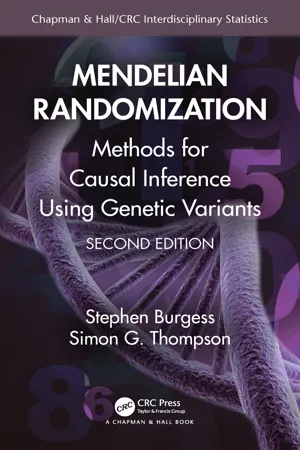
Mendelian Randomization
Methods for Causal Inference Using Genetic Variants
- 226 pages
- English
- ePUB (mobile friendly)
- Available on iOS & Android
Mendelian Randomization
Methods for Causal Inference Using Genetic Variants
About this book
Mendelian Randomization: Methods For Causal Inference Using Genetic Variants provides thorough coverage of the methods and practical elements of Mendelian randomization analysis. It brings together diverse aspects of Mendelian randomization from the fields of epidemiology, statistics, genetics, and bioinformatics.
Through multiple examples, the first part of the book introduces the reader to the concept of Mendelian randomization, showing how to perform simple Mendelian randomization investigations and interpret the results. The second part of the book addresses specific methodological issues relevant to the practice of Mendelian randomization, including robust methods, weak instruments, multivariable methods, and power calculations. The authors present the theoretical aspects of these issues in an easy-to-understand way by using non-technical language. The last part of the book examines the potential for Mendelian randomization in the future, exploring both methodological and applied developments.
Features
- Offers first-hand, in-depth guidance on Mendelian randomization from leaders in the field
- Makes the diverse aspects of Mendelian randomization understandable to newcomers
- Illustrates technical details using data from applied analyses
- Discusses possible future directions for research involving Mendelian randomization
- Software code is provided in the relevant chapters and is also available at the supplementary website
This book gives epidemiologists, statisticians, geneticists, and bioinformaticians the foundation to understand how to use genetic variants as instrumental variables in observational data.
New in Second Edition: The second edition of the book has been substantially re-written to reduce the amount of technical content, and emphasize practical consequences of theoretical issues. Extensive material on the use of two-sample Mendelian randomization and publicly-available summarized data has been added. The book now includes several real-world examples that show how Mendelian randomization can be used to address questions of disease aetiology, target validation, and drug development
Frequently asked questions
- Essential is ideal for learners and professionals who enjoy exploring a wide range of subjects. Access the Essential Library with 800,000+ trusted titles and best-sellers across business, personal growth, and the humanities. Includes unlimited reading time and Standard Read Aloud voice.
- Complete: Perfect for advanced learners and researchers needing full, unrestricted access. Unlock 1.4M+ books across hundreds of subjects, including academic and specialized titles. The Complete Plan also includes advanced features like Premium Read Aloud and Research Assistant.
Please note we cannot support devices running on iOS 13 and Android 7 or earlier. Learn more about using the app.
Information
Part I
Understanding and performing Mendelian randomization
1
Introduction and motivation
1.1 Shortcomings of classical epidemiology
1.1.1 Randomized trials and observational studies
1.2 The rise of genetic epidemiology
1.2.1 Historical background
Table of contents
- Cover
- Half Title
- Series Page
- Title Page
- Copyright Page
- Contents
- Preface to the second edition
- Abbreviations
- Notation
- I Understanding and performing Mendelian randomization Understanding and performing Mendelian randomization
- II Advanced methods for Mendelian randomization
- III Prospects for Mendelian randomization
- Bibliography
- Index